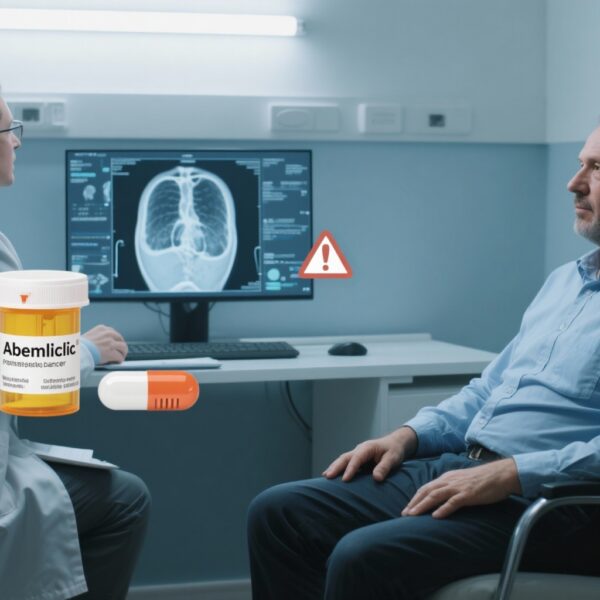Highlight
– Interim TRIM results (n=983, median follow-up 33.6 months) show no statistically significant difference in overall survival or distant metastasis‑free survival when routine whole‑body CT or FDG‑PET‑CT is added to physical‑examination follow‑up versus physical examination alone after radical surgery for stage IIB–C and III cutaneous malignant melanoma.
– 3‑year overall survival was 88.2% with physical examinations alone versus 87.7% with added imaging; hazard ratio (HR) for overall survival 1.04 (95% CI 0.71–1.51, p=0.85).
– Numerical differences in distant metastasis‑free survival favor the physical‑examination group modestly (81.6% vs 79.3% at 3 years), motivating continuation of the trial to planned accrual and 5‑year primary endpoint analysis.
Background and disease burden
Cutaneous malignant melanoma incidence has risen globally over recent decades. For patients with high‑risk resected disease (stage IIB–C and III), the risk of recurrence — particularly distant metastasis — is substantial, and surveillance strategies aim to detect recurrence early when interventions may be more effective. In many health systems, routine whole‑body imaging (CT or [18F]fluorodeoxyglucose‑PET‑CT) has been adopted for follow‑up of high‑risk patients despite limited randomized evidence that systematic scanning improves long‑term survival. Imaging carries potential benefits (earlier detection of asymptomatic metastases) but also harms and costs (radiation exposure, contrast risks, false positives, anxiety, downstream procedures, resource utilization). The TRIM trial was designed to provide randomized evidence on whether scheduled whole‑body radiological surveillance added to physical examinations improves outcomes compared with physical examinations alone.
Study design
TRIM is a multicentre, randomized, phase 3 trial conducted in Sweden (ClinicalTrials.gov NCT03116412). Key eligibility criteria included adults (≥18 years) with sufficient renal function for contrast‑enhanced CT and fitness to receive recurrence therapy if needed, following radical surgery for stage IIB–C or III cutaneous malignant melanoma. Participants were randomized 1:1 (stratified by tumour stage and method of radiological assessment) to 3 years of either:
- Physical examinations alone at predefined intervals (standard group), or
- Physical examinations plus whole‑body imaging (contrast‑enhanced CT or FDG‑PET‑CT) at baseline, 6, 12, 24 and 36 months (experimental group).
The trial planned to recruit 1,300 participants with 5‑year overall survival as the primary endpoint. The report under discussion is a prespecified interim analysis without predefined efficacy endpoints; outcomes presented include overall survival (OS), relapse‑free survival (RFS), locoregional relapse‑free survival, and distant metastasis‑free survival (DMFS), analyzed by intention to intervene.
Key findings
Between June 8, 2017 and July 28, 2023, 983 participants were randomized: 498 to physical examinations alone (standard group) and 485 to physical examinations plus routine whole‑body imaging (experimental group). Baseline sex distribution was similar between groups; the median follow‑up was 33.6 months (IQR 16.3–49.8).
Primary interim comparisons
At this interim timepoint there were no statistically significant differences between groups in the principal outcomes presented:
- Overall survival: median OS not reached in either group; HR 1.04 (95% CI 0.71–1.51), p=0.85. Three‑year OS was 88.2% (95% CI 85.0–91.6) in the standard group versus 87.7% (84.3–91.3) in the experimental group.
- Distant metastasis‑free survival: median not reached in either group; HR 1.20 (95% CI 0.89–1.64), p=0.24. Three‑year DMFS was 81.6% (95% CI 77.9–85.6) in the standard group versus 79.3% (75.3–83.5) in the imaging group.
Relapse‑free and locoregional relapse‑free survival were reported but did not demonstrate statistically significant differences in this interim analysis.
Interpretation of effect sizes and statistical context
Hazard ratios close to unity and wide confidence intervals reflect limited event numbers and relatively short median follow‑up for a trial powered for 5‑year OS. The point estimates slightly favored physical examinations for DMFS and were essentially neutral for OS. P values indicate no evidence of benefit from adding scheduled imaging at this interim stage. The trial team elected to continue enrollment and follow‑up because only a minority of participants have reached the planned 5‑year endpoint and because the numerical DMFS difference, though non‑significant, could be clinically relevant if it persists with more events.
Expert commentary and context
These interim TRIM results are important because they challenge the assumption that routine scheduled whole‑body imaging during follow‑up improves survival for patients with resected high‑risk melanoma. Several mechanistic and practical considerations help contextualize the findings:
Lead‑time and length biases versus true survival benefit
Imaging can detect asymptomatic metastases earlier than clinical signs, producing lead‑time bias without changing the natural history if earlier detection does not allow more effective curative interventions. The lack of OS difference so far could reflect lead‑time without therapeutic advantage, or it may be that effective systemic therapies at recurrence (immune checkpoint inhibitors, targeted agents) reduce the marginal benefit of earlier detection.
Impact of modern adjuvant therapies
The TRIM recruitment period overlapped the increasing use of effective adjuvant therapies for stage III disease (immune checkpoint inhibitors and BRAF/MEK inhibitors for appropriate patients). Adjuvant therapy reduces recurrence risk and may alter the absolute potential benefit of surveillance imaging; patients receiving effective adjuvant therapy may have fewer recurrences amenable to earlier detection by imaging.
Harms, costs, and downstream consequences
Routine imaging introduces radiation exposure (relevant with serial CT), contrast nephrotoxicity risk, incidental findings that prompt invasive testing, and psychological impacts from false positives. Resource utilization and cost‑effectiveness are important system considerations; if no survival benefit exists, routine imaging’s harms and costs become harder to justify.
Generalizability and remaining uncertainties
Strengths of TRIM include randomized design, multicenter conduct, and pragmatic imaging choices (CT or FDG‑PET‑CT). Limitations at this interim stage include incomplete maturation of the primary endpoint, potential heterogeneity in imaging modality and interpretation, and evolving systemic therapy landscapes during recruitment. Subgroup analyses by stage (IIB vs IIC vs stage III subcategories), BRAF status, or receipt of adjuvant therapy will be informative when reported, as will data on stage at recurrence, patterns of relapse, salvage treatments given, and quality‑of‑life outcomes. The TRIM investigators appropriately continue follow‑up to the planned 5‑year endpoint to address these questions.
Clinical implications
For clinicians and health systems, the interim TRIM data provide the following practical considerations:
- There is currently no randomized evidence from TRIM that scheduled whole‑body imaging improves early overall survival in resected stage IIB–C and III melanoma. Routine scheduled imaging should not be assumed to confer survival advantage based on these interim results.
- Decisions about surveillance strategies should weigh patient preferences, risk of recurrence, availability and timing of adjuvant therapies, potential harms of imaging, and resource constraints. Shared decision‑making remains appropriate.
- Until final 5‑year outcomes and subgroup analyses are available, centers with established imaging protocols may consider maintaining individualized follow‑up approaches, but policies endorsing universal scheduled whole‑body scanning for all high‑risk patients should be re‑examined in light of accumulating randomized evidence.
Trial limitations and questions for future analyses
Key limitations to keep in mind are the interim nature of the report and possible evolution in background therapies and imaging technology over the course of recruitment. Important questions for the final report include:
- Do specific subgroups (e.g., stage II vs III substage, BRAF‑mutant patients, those who did or did not receive adjuvant therapy) derive differential benefit or harm from routine imaging?
- Does earlier imaging detect recurrences at a stage that changes management (e.g., resectable oligometastatic disease) and does that translate into durable survival benefit?
- What are the downstream harms, false positive rates, procedure rates, and health‑economic implications of routine imaging versus clinical follow‑up?
Conclusion
The interim TRIM analysis (n=983, median follow‑up 33.6 months) found no evidence that adding scheduled whole‑body CT or FDG‑PET‑CT to physical‑examination follow‑up improves overall survival or distant metastasis‑free survival for patients after radical surgery for stage IIB–C and III cutaneous malignant melanoma. Given immature 5‑year data and a non‑definitive numerical signal in DMFS, continuation of the trial to planned accrual and follow‑up is appropriate. Clinicians should interpret these interim data as a prompt to reassess routine universal imaging policies and to individualize surveillance strategies while awaiting final trial results and detailed subgroup analyses.
Funding and trial registration
The study is funded by Stiftelsen Onkologiska Klinikens i Uppsala Forskningsfond and Uppsala University Hospital. TRIM is registered at ClinicalTrials.gov: NCT03116412.
Key reference
Ladjevardi CO, Naeser Y, Dyrke U, Papantoniou D, Bagge RO, Elander N, Ingvar C, Flygare P, Nilsson C, Jakobsson F, Lange-Norström K, Sundin A, Berglund A, Nyberg F, Ahringberg‑Kald B, Helgadottir H, Ullenhag G. Physical examinations and whole‑body imaging versus physical examinations alone during follow‑up after radical surgery of stage IIB‑C and III cutaneous malignant melanoma (TRIM): an interim analysis of a multicentre, randomised, phase 3 trial in Sweden. Lancet Oncol. 2025 Nov;26(11):1501‑1510. doi: 10.1016/S1470-2045(25)00487-5. PMID: 41167217.
Suggested reading and guideline resources
For clinicians updating practice, consult contemporary guideline documents for surveillance after resected melanoma (for example national melanoma guidelines and institutional protocols), and monitor the TRIM final report for prespecified subgroup and health‑economics analyses that will inform more definitive recommendations.



